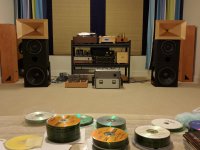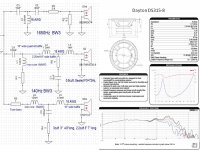Hi guys,
I lately was gifted a pair of wood horn with built in drivers and a pair of 12" bass driver - Dayton DS315-8. As of my friend, I only have to build a pair of box for the woofer and it's good to go. The horn's cut off at 400hz.
I'm a complete newbie on speaker design and or crossover design. I'd like to build a pair of 3cu.ft. vented box and tune to 30hz if possible. I love bass, smooth bass. I want the box height around 28-30" so to sit the wood horn right on top. I figure the size around 12"w x 16"D x 28"H but don't know if it is a good reasonable proportion. Please don't hesitate to give any valuable ideas and advices that you can think of.
Thanks in advance
Albert
I lately was gifted a pair of wood horn with built in drivers and a pair of 12" bass driver - Dayton DS315-8. As of my friend, I only have to build a pair of box for the woofer and it's good to go. The horn's cut off at 400hz.
I'm a complete newbie on speaker design and or crossover design. I'd like to build a pair of 3cu.ft. vented box and tune to 30hz if possible. I love bass, smooth bass. I want the box height around 28-30" so to sit the wood horn right on top. I figure the size around 12"w x 16"D x 28"H but don't know if it is a good reasonable proportion. Please don't hesitate to give any valuable ideas and advices that you can think of.
Thanks in advance
Albert
I've been cruising around the forums and found some more informations that might be suit to my application. Members suggested to run this speaker in a 1.9 - 2.2 cu.ft ID tuned to 37f3. I come up with the number 11" x 15" x 23" ID = 2.196 cu.ft.
Do I have to add on the speaker displacement and the bracing on top of those numbers?
Regards
Albert
Do I have to add on the speaker displacement and the bracing on top of those numbers?
Regards
Albert
Normally internal displacement of driver and any port or other hardware are subtracted from the internal volume (its the air that acts as the spring in the resonant system after all). Adding accoustic wadding effectively enlarges the volume a bit though, so you can maybe just assume one will cancel the other roughly.
Normally internal displacement of driver and any port or other hardware are subtracted from the internal volume (its the air that acts as the spring in the resonant system after all). Adding accoustic wadding effectively enlarges the volume a bit though, so you can maybe just assume one will cancel the other roughly.
Does it mean I just go for the size as is ?
Not necessarily since the amount of stuffing required may roll off the bass too much: Sub Box Polyester Fiberfill
GM
GM
Hi guys,
I figure the size around 12"w x 16"D x 28"H
The horn's cut off at 400hz.
Albert
The metal frame diameter of the DS315 is 12.4"
You probably mixed D&W: 12"D x 16"W x 28"H
What are the dimensions of your horn?
---Do you have measurements / spec-sheet?
Typically, -F3 = 400Hz horns are wider than 16".
Not necessarily since the amount of stuffing required may roll off the bass too much: Sub Box Polyester Fiberfill
GM
Thanks GM for the link
The metal frame diameter of the DS315 is 12.4"
You probably mixed D&W: 12"D x 16"W x 28"H
What are the dimensions of your horn?
---Do you have measurements / spec-sheet?
Typically, -F3 = 400Hz horns are wider than 16".
LineSource,
Happy to have you here. You knows this driver and did recommended this to couple members within this forum.
The synergy horn I talked about was designed by Bill Waslo of which I finished couple years ago. The reason I build this bass box is I can't find the woofers that he used for this design. I just put a 15" Bass with a bit Eq. But don't find I am in the right track. I really would like to run all this with one power amp.
The synergy horn is 93/94 dB and the horn's width is 22". I know the 315-8 is 90dB. I might need a bit of boost but don't know how I can achieve this.
Regards
Albert
The Dayton DS315-8 got a Qts of 0,31. That means, in a sealed enclosure it won't go deep, that's a typical BR driver. If you use enough polyester wadding to actually achieve virtual volume increase, your bassreflex port will hardly work anymore. The minimum usable BR enclosure size for the DS315 is around 50l, 60l would be better (sry, won't convert and calculate the measurements into imperial units, too tired).
The Dayton DS315-8 got a Qts of 0,31. That means, in a sealed enclosure it won't go deep, that's a typical BR driver. If you use enough polyester wadding to actually achieve virtual volume increase, your bassreflex port will hardly work anymore. The minimum usable BR enclosure size for the DS315 is around 50l, 60l would be better (sry, won't convert and calculate the measurements into imperial units, too tired).
60L is 2.1188 pretty close to 2.2cu. ft
You're welcome!
GM
After reading the article, I think for my ported box, a pound a foot is about right.
I'd like to build a pair of 3cu.ft. vented box and tune to 30hz if possible.
I want the box height around 28-30" so to sit the wood horn right on top. I figure the size around 12"w x 16"D x 28"H but don't know if it is a good reasonable proportion.
3 ft^3 is a good size once the driver, vent, bracing is factored in though from looking at your room, thinking tuning to ~27 Hz will be better overall. To keep vent mach reasonable, 4" dia. x 12.68".
Recommend the baffle, top plate be at least the same width as the horn and ideally at least 30" to offset baffle step loss even if the cab isn't. The cab itself can be some golden or acoustic ratio. If the baffle is wider than the horn, then it too ideally needs a same width baffle that extends above it a like amount.
GM
After reading the article, I think for my ported box, a pound a foot is about right.
If you build the 3 ft^3 in a golden or acoustic ratio, you'll only need minimal damping on one wall, back and top to quell any 'hollowness'.
GM
Thanks GM for the fast response.3 ft^3 is a good size once the driver, vent, bracing is factored in though from looking at your room, thinking tuning to ~27 Hz will be better overall. To keep vent mach reasonable, 4" dia. x 12.68".
Recommend the baffle, top plate be at least the same width as the horn and ideally at least 30" to offset baffle step loss even if the cab isn't. The cab itself can be some golden or acoustic ratio. If the baffle is wider than the horn, then it too ideally needs a same width baffle that extends above it a like amount.
GM
I really don't mind a big box, I love bass.
Should I need a baffle so wide? My intention is to put the horn on top of the woofer.
Regards
If you build the 3 ft^3 in a golden or acoustic ratio, you'll only need minimal damping on one wall, back and top to quell any 'hollowness'.
GM
Copied n thanks
You're welcome!
Actually, I prefer classic alignments, so personally would build [measured] Vas/1.44 [net] tuned to Fs, so assuming Vas, Fs is reasonably accurate: ~3.9 net/4.1 ft^3, 24.2 Hz Fb. A 'tighter' sounding alignment with typically a better blend to the room, but the trade-off is less power handling in the ~30-50 Hz BW, though near wall locations tend to fill it in and cause smaller cabs/higher tunings to be a bit 'loose/'boomy' in some apps.
The other advantage, and the main reason for me preferring/recommending larger cabs, is they have more tuning flexibility, so can always shrink, re-tune it if need be.
Understood and why I posted what I did.
If you want a tonally balanced system, then some form of baffle step compensation is required, so either need a wide enough baffle and/or either boosting or shelving EQ, both of which reduces dynamic headroom, though boosting the lows is usually the lesser of two evils, another good reason to tune low as practical.
GM
Actually, I prefer classic alignments, so personally would build [measured] Vas/1.44 [net] tuned to Fs, so assuming Vas, Fs is reasonably accurate: ~3.9 net/4.1 ft^3, 24.2 Hz Fb. A 'tighter' sounding alignment with typically a better blend to the room, but the trade-off is less power handling in the ~30-50 Hz BW, though near wall locations tend to fill it in and cause smaller cabs/higher tunings to be a bit 'loose/'boomy' in some apps.
The other advantage, and the main reason for me preferring/recommending larger cabs, is they have more tuning flexibility, so can always shrink, re-tune it if need be.
Understood and why I posted what I did.
If you want a tonally balanced system, then some form of baffle step compensation is required, so either need a wide enough baffle and/or either boosting or shelving EQ, both of which reduces dynamic headroom, though boosting the lows is usually the lesser of two evils, another good reason to tune low as practical.
GM
Thanks GM,You're welcome!
Actually, I prefer classic alignments, so personally would build [measured] Vas/1.44 [net] tuned to Fs, so assuming Vas, Fs is reasonably accurate: ~3.9 net/4.1 ft^3, 24.2 Hz Fb. A 'tighter' sounding alignment with typically a better blend to the room, but the trade-off is less power handling in the ~30-50 Hz BW, though near wall locations tend to fill it in and cause smaller cabs/higher tunings to be a bit 'loose/'boomy' in some apps.
The other advantage, and the main reason for me preferring/recommending larger cabs, is they have more tuning flexibility, so can always shrink, re-tune it if need be.
Understood and why I posted what I did.
If you want a tonally balanced system, then some form of baffle step compensation is required, so either need a wide enough baffle and/or either boosting or shelving EQ, both of which reduces dynamic headroom, though boosting the lows is usually the lesser of two evils, another good reason to tune low as practical.
GM
I don't mind big box really. I still remember I once making a 4.5 cu. ft box for the JBL LE14a. The result is stunning but found the mid not that adorable up to 1.5k cross-over point.
I'd keep the size at 2.5 - 3 cu. ft for this. I'm try to skip the eq if possible therefore I could run with one power amp. I need help in the design of that 280/300Hz cross-over with the boost. I know nothing about crossover, been trying many times sim with the web program with no success. I end up with lots of parts laying around. LineSource, wish you can chim in.
Regards
- Status
- This old topic is closed. If you want to reopen this topic, contact a moderator using the "Report Post" button.
- Home
- Loudspeakers
- Multi-Way
- Dayton DS315-8 12" woofer box

